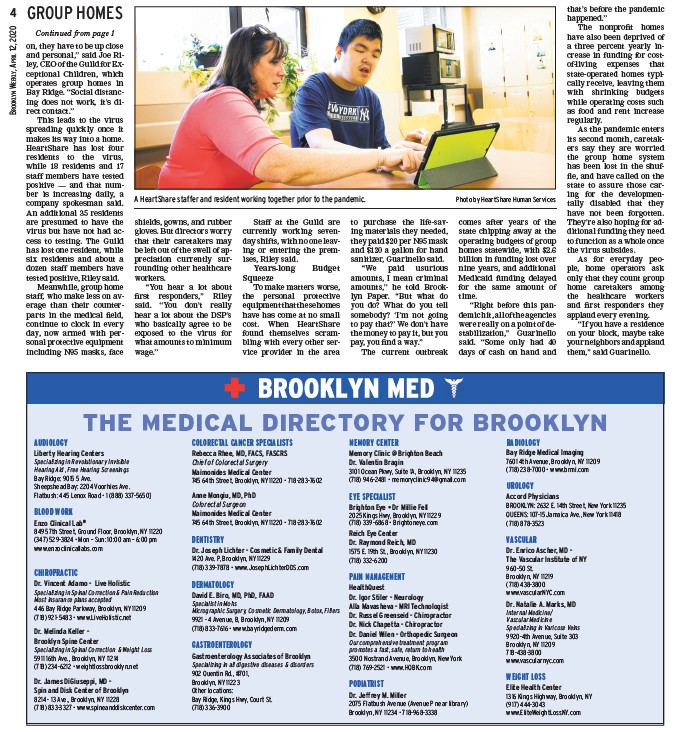
4
BROOKLYN WEEKLY, APRIL 12, 2020
GROUP HOMES
on, they have to be up close
and personal,” said Joe Riley,
CEO of the Guild for Exceptional
Children, which
operates group homes in
Bay Ridge. “Social distancing
does not work, it’s direct
contact.”
This leads to the virus
spreading quickly once it
makes its way into a home.
HeartShare has lost four
residents to the virus,
while 18 residents and 17
staff members have tested
positive — and that number
is increasing daily, a
company spokesman said.
An additional 35 residents
are presumed to have the
virus but have not had access
to testing. The Guild
has lost one resident, while
six residents and about a
dozen staff members have
tested positive, Riley said.
Meanwhile, group home
staff, who make less on average
than their counterparts
in the medical fi eld,
continue to clock in every
day, now armed with personal
protective equipment
including N95 masks, face
shields, gowns, and rubber
gloves. But directors worry
that their caretakers may
be left out of the swell of appreciation
currently surrounding
other healthcare
workers.
“You hear a lot about
fi rst responders,” Riley
said. “You don’t really
hear a lot about the DSP’s
who basically agree to be
exposed to the virus for
what amounts to minimum
wage.”
Staff at the Guild are
currently working sevenday
shifts, with no one leaving
or entering the premises,
Riley said.
Years-long Budget
Squeeze
To make matters worse,
the personal protective
equipment that these homes
have has come at no small
cost. When HeartShare
found themselves scrambling
with every other service
provider in the area
to purchase the life-saving
materials they needed,
they paid $20 per N95 mask
and $120 a gallon for hand
sanitizer, Guarinello said.
“We paid usurious
amounts, I mean criminal
amounts,” he told Brooklyn
Paper. “But what do
you do? What do you tell
somebody? ‘I’m not going
to pay that?’ We don’t have
the money to pay it, but you
pay, you fi nd a way.”
The current outbreak
comes after years of the
state chipping away at the
operating budgets of group
homes statewide, with $2.6
billion in funding lost over
nine years, and additional
Medicaid funding delayed
for the same amount of
time.
“Right before this pandemic
hit, all of the agencies
were really on a point of destabilization,”
Guarinello
said. “Some only had 40
days of cash on hand and
that’s before the pandemic
happened.”
The nonprofi t homes
have also been deprived of
a three percent yearly increase
in funding for costof
living expenses that
state-operated homes typically
receive, leaving them
with shrinking budgets
while operating costs such
as food and rent increase
regularly.
As the pandemic enters
its second month, caretakers
say they are worried
the group home system
has been lost in the shuffl
e, and have called on the
state to assure those caring
for the developmentally
disabled that they
have not been forgotten.
They’re also hoping for additional
funding they need
to function as a whole once
the virus subsides.
As for everyday people,
home operators ask
only that they count group
home caretakers among
the healthcare workers
and fi rst responders they
applaud every evening.
“If you have a residence
on your block, maybe take
your neighbors and applaud
them,” said Guarinello.
A HeartShare staffer and resident working together prior to the pandemic. Photo by HeartShare Human Services
Continued from page 1
����������������������������������������������������������������������
������������������
����������������������������������������������
������������������������������������������������������������������������������������
��������������������������������������������������������������������������
��������������������������������������������
��������������������������������������������������������������������
����������������������������������������������������������������������������������������
��������������������
������������������������������������
����������������������������������������������������������������������������������������������������
����������������������������������������������������������������������������������������������
�������������������������������������������������� �� ��
������������������������
��������������������������������������������������������������������
������������������������������������������������������������������������������������������������������
����������������������������������������������������������
����������������������������������������������������������������������������������
��������������������������������������������������������������������������
������������������������������������������ �� ��
������������������������������������������
������������������������������������������������������������������������������������������������
��������������������������������������������������������������������
������������������������������������������������������������������������������
����������������������������������������������������
����������������������������������������������������������������
������������������������������������������������������������������������
��������������������������������������������������������������������������������������
����������������������������������������������������������
���������������������������������������������������������������� ��
������������������������������������������������������
��������������������������������������������������
����������������������������������������������������������������������������������������������������
�������������������������������������������� ��
������������������������������������
��������������������������������������������������
����������������������������������������������������������������������������������������������������
������������������
������������������������������������������������������������������������������������������
��������������������������������������������������������������
����������������������������������������������������������������������������������
����������������������
��������������������������������������������������������
����������������������������������������
��������������������������������������������������������������������������������������������������������������������
����������������������������������������������������������������������������
��������������������������������������������������������������������������
��������������������������������
������������������������������������������������������������������������������
������������������������������������������������������������������������������������������������������
����������������������������������������������
������������������������������������
��������������������������������
��������������������������������������������������������������
����������������������������
��������������������������
������������������������������������������������������������
��������������������������������������
����������������������������������������������������������������������������������������������
������������������������������������������������������������������������������������
����������������������������
����������������������������������������������������������
��������������������������������������������������������������������
����������������������������������������������������������������
����������������������������������
������������������������������������������
����������������������������������������������������������������������������
����������������������������
������������������������������
������������������������
������������������������������������������������������
������������������������������������������������������������������
����������������������������������������������������������������������
����������������������������������������������������������������
��������������������������������������������������������������������������
��������������������������������������������������������������������������
������������������������������������������������������������������������������
��������������������������������������������������������������������������������
����������������������������������������������������������
��������������������
������������������������������������������
����������������������������������������������������������������������������������������
�������������������������������������������������������������������� �� ��
������������������
��������������������������������������������������
��������������������������������������������������������������������������
����������������������������������������������������������
��������������
����������������������������������
������������������������������������������������������������������������������������������
��������������������������������������������������������������������������������������
����������������������������
������������������
����������������������������������������������
��������������������������������������������������������
���������������������� �� �� ��
����������������������������������������
������������������������������
��������������������������������������
������������������������������������������������
��������������������������������������
������������������������������������
������������������������������������������������������������
������������������������������������������������������
��������������������������������������
��������������������������
��������������������������������������
������������������������
����������������������������������������
��������������������������������������������������������������������
������������������������������
��������������������������������������������������